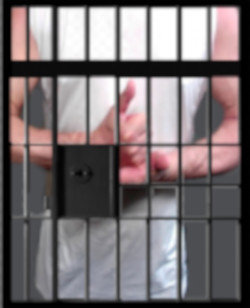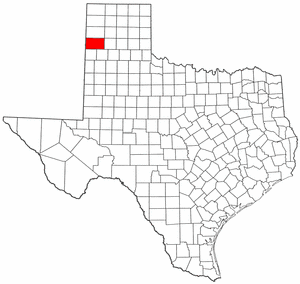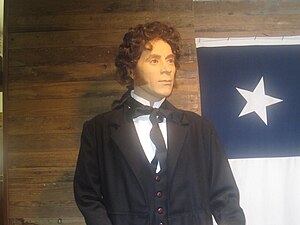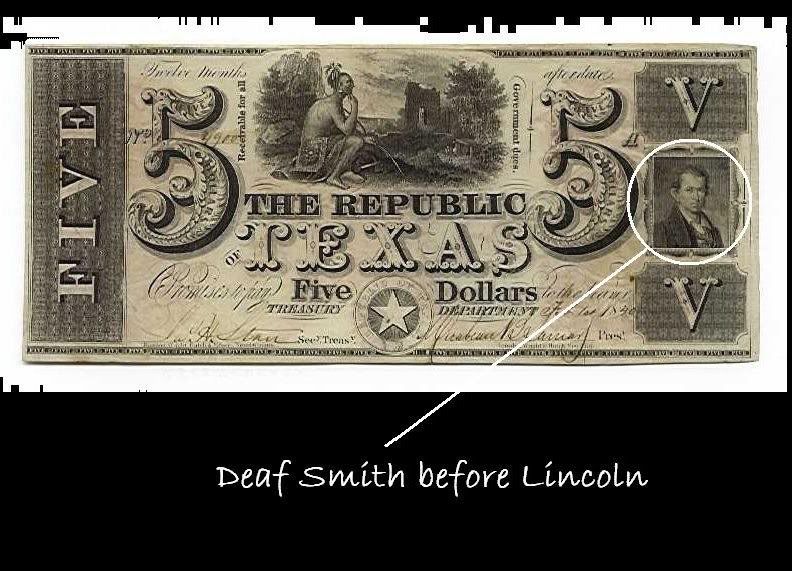 By Jean F. Andrews
By Jean F. Andrews
[Author’s Note: If you live in Texas, you know about Deaf Smith, a popular hero among deaf and hearing Texans alike. Dr. Steve Baldwin a prolific writer, presenter and trained historian, shares his Deaf culture research with deafinprison readers. Dr. Baldwin gives us a fresh perspective on Deaf Smith’s role in Texas history. (Jean Andrews)]
***
In Retrospect: On the State of Seeking Deaf Smith by Dr. Steve Baldwin
Since the inaugural 17-part exhibit of Erastus “Deaf” Smith’s 225th birthday celebration on the ground floor of the Texas State Capitol rotunda from April 18 to 20, 2012 and subsequent tours across the state, which ended on October 25 in Dallas, I decided to sum up my experience as the primary exhibitor, researcher, and writer since I first seriously studied about Deaf Smith (1787-1817), the famous “Texian” spy, scout, ranger and pioneer about 32 years ago.
Of course, the method of studying, researching and theorizing evolved over time with the advent of technology, Internet, new information, accessible papers, better archives and libraries. To go from a thin folder of information about Deaf Smith in the Baker Library for American History that was renamed Dolph Briscoe Center for American History at the University of Texas at Austin to two standard file boxes of my personal collection testifies for hard work, dedication, focus and a passion that has not abated over time. One word of advice to sincere future researchers and writers: do not bother to locate Smith’s missing and unmarked gravesite in Richmond, Texas since early 1830s burial sites are difficult to pinpoint due to customs, pine coffins, unclear town maps and complicated legal issues.
However, my alarming concern now is the lack of quality research because of the onslaught of vlogs and blogs that appear to epitomize inaccurate historical information about Smith’s life and feats. The worst case of plagiarism from the book (1973) by the definitive biographer of Deaf Smith named Cleburne Huston (1894-1989) came from a national deaf magazine. None of the magazine writers, albeit no respective bylines, actually took the time to research and verify their material, visit archives, and even worst, give their citations the necessary documented credit. Consequently, my role went from historian to vigilant against blatant plagiarism and online piracy of published work and the lack of historical accuracy.
Let’s move on from the wanton disregard for honest publishing and researching to the three most common questions that came from school-aged students during the fall exhibit tour. First query: “Was Deaf Smith really deaf.” Based on contemporary 2nd and third-party witnesses and other documented information, Smith was deafened and his hearing became progressively worst, as he got older. His speech shape was fraught with high-pitched sounds, but intellectual enough to be understood. Research shows that he was quite the loner, hunted alone with his hearing dog, and abhorred group discussions or social life on the frontier.
The second most common question was: “Why do we have very few written documents from Deaf Smith himself?” First of all, he was quite a busy backwoodsman, always hunting, surveying, exploring or defending a Central Texas town from marauding bandits and warring Comanches. Although he had a good command of English, spoken or written, he was not a consistent literary man. There are relatively very few first-person accounts on record. However, thanks to his historic legacy and many legends in Texas, his fame was well documented in periodicals, diaries, journals, newspapers, family history, historical paintings and biographies of his contemporaries.
The third common question was: “How was Deaf Smith able to achieve so many incredible military feats in a span of seven months?” Keep in mind that he was chosen personally by General Sam Houston because of Smith’s reputation as a proven scout in early 19th century Texas. Such an assignment speaks volumes about Smith’s reputation as being the “eyes of the Texian army.” Based on his visual acuity, Smith knew the land, rivers and critters of Texas by heart, mind and soul, albeit smelling and feeling. He proved his leadership by commanding a spy and scout company, which made pivotal decisions that tipped the war in favor of the Texas independence in April of 1836. That band of soldiers saved Houston’s troops more than once, numbering about five documented activities, including the destruction of a strategic bridge.
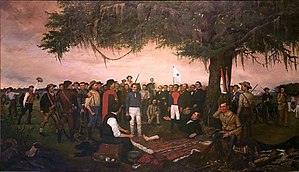
“Surrender of Santa Anna” by William Huddle (1847–92), 1886 The painting “Surrender of Santa Anna” by William Huddle, shows the Mexican strong-man surrendering to a wounded Sam Houston. (Photo credit: Wikipedia)
If one would goggle the painting called “The Surrender of Santa Anna,” there is the evidence that Smith played a prominent and crucial role in the Battle of San Jacinto. In fact, the painter, William H. Huddle (1847-1892) literally interviewed the veterans who substantiated Smith’s role as the true hero of the victorious battle. In a nutshell, Smith was a seasoned soldier, determined person, proven survivor, courageous warrior and attitudinal barrier fighter.
In closing my special article for this website, I wish to announce that I intend to donate my Deaf Smith collection of documents, artifacts, research notes, photos, my filmed play, a monograph, and historic prints to the University of Texas at Austin. Such a collection in one of their libraries, be it the Briscoe Center or the Brockett Center, will allow future researchers to continue my passionate research and publish more new and accurate information about Texas’ most amazing military hero who was not “afraid of whizzing bullets” or “felt the bite before the bark of the dog.”

Steve Baldwin and “Deaf Smith.” Courtesy Jean F. Andrews
Contact Dr. Steve Baldwin for his publications on Deaf Smith.

Steve Baldwin Image courtesy of Jean F. Andrews
Related articles
- Lipreading: What It Is, What It Isn’t (deafinprison.wordpress.com)
- Deaf Males and Sex Crime (deafinprison.wordpress.com)
- The Role of Early ASL Learning and Linguistic Competence of Deaf Individuals (deafinprison.wordpress.com)
- Deaf Couple use Internet and Technology to Run Restaurant (deafinprison.wordpress.com)
- So, What Do You Need to Know About ASL Name Signs? Workshop by Professor Andrew Byrne (deafinprison.wordpress.com)
- Third Grade Reading Level: What Does It Mean for An Adult Deaf Suspect? (deafinprison.wordpress.com)
- Filipino Sign Language Bill’s struggle for acceptance continues (deafphilippines.wordpress.com)
